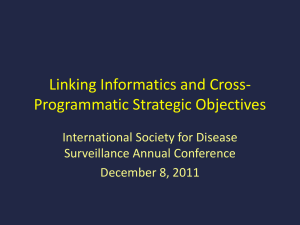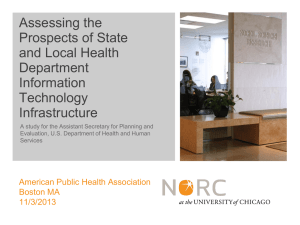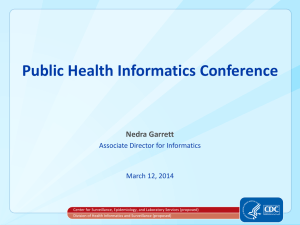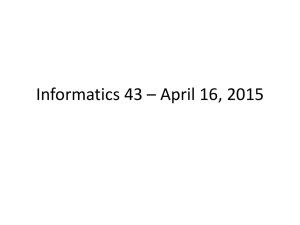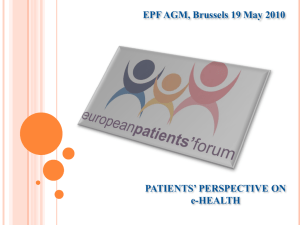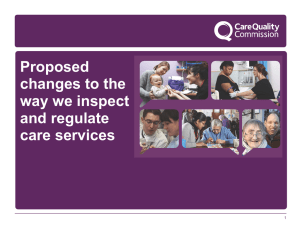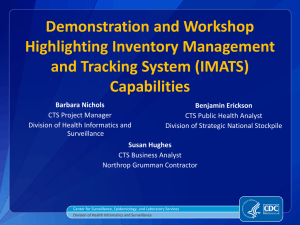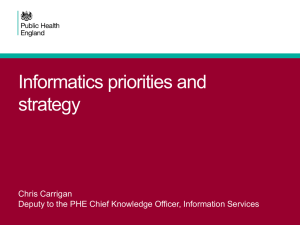CLWG_OHSI_Orientation
advertisement
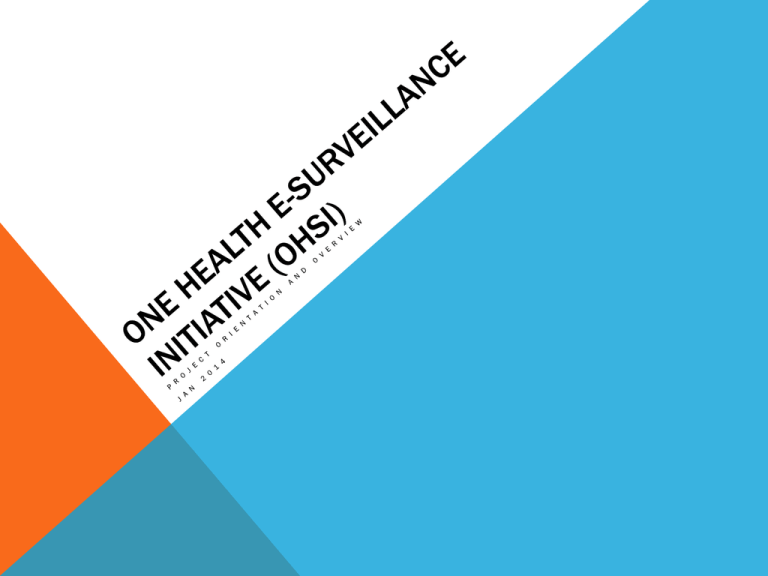
ONE HEALTH E-SURVEILLANCE INITIATIVE (OHSI) Goal To support the implementation of the Integrated Disease Surveillance and Response (IDSR) plan by contributing strategies that can embed public health informatics, thereby making IDSR more effective and efficient To this end… OHSI will assist pilot countries to develop a targeted strategy for leveraging electronic surveillance (e-Surveillance) tools to meet their needs and IDSR objectives using a one health approach ONE HEALTH E-SURVEILLANCE INITIATIVE (OHSI) Objectives To establish national workgroups that will develop country-specific, transnationally aligned, and globally informed strategic plans for implementing e-Surveillance abiding by IDSR and International Health Regulations (IHR[2005]) strategies and guidelines To provide evidence-based information to inform the African Surveillance Informatics Governance Board (ASIGB), the regional workgroup led by the World Health Organization’s African Regional Office (WHO/AFRO) for e-Surveillance WHAT IS ONE HEALTH? A one health approach recognizes the relationships between the human, animal, and environmental health, and applies interdisciplinary tools to solve complex public health problems. Human Human Animal Animal One Health Environmental Environmental TRADITIONAL PUBLIC HEALTH MODEL ONE HEALTH APPROACH Source: Gael Lamielle WHAT IS ONE HEALTH? A one health approach may incorporate a variety of fields. Our project, the One Health e-Surveillance Initiative will focus on public health, veterinary medicine, human medicine, and microbiology (laboratory) fields Environmental Health Public Health Veterinary Medicine Ecology Health Economics Molecular and Microbiology Human Medicine Source: One Health Initiative/One Health Sweden WHY ONE HEALTH IS IMPORTANT Approximately 70% of emerging and reemerging infections are vector-borne or zoonotic. Source: International Livestock Research Institute WHAT IS E-SURVEILLANCE? “Public health surveillance is the continuous, systematic collection, analysis and interpretation of health-related data needed for the planning, implementation, and evaluation of public health practice.” (WHO) Electronic surveillance (e-Surveillance) utilizes information technologies, such as specialized software for epidemiological statistics or outbreak management, to perform public health functions. An e-Surveillance tool is a means to streamline manual processes to reduce opportunity for human error, improve the flow and timeliness of surveillance data for public health action, and increase surveillance capacity and data quality. E-SURVEILLANCE COMPONENTS The e-Surveillance environment is comprised of various components, each of which are included in a robust e-Surveillance strategy. Role of Components: Enabling, Information Communications Technology Leadership, governance, and multi-sector engagement coordinate at national level, enable adoption of e-Surveillance components, support and implementation, monitor results Strategy and Investment ensure comprehensive, multi-sectoral engagement coordination in planning and financing Standards and Interoperability ensure consistent data collection and exchange Services and Applications tools for data access, exchange, and management Infrastructure physical infrastructures (e.g., internet) and supporting services Legislation, Policy, and Compliance adopt enabling policies and legislation, create legal and enforcement environment Workforce grow eSurveillance knowledge and skills, build networks, establish education and training programs Adapted from source: WHO National e-Health Strategy Toolkit E-SURVEILLANCE CAPACITY BUILDING E-Surveillance tools are only as useful and capable as the underpinning infrastructure that supports it. Electronic Tools Enable effective use of… Require… Systems and Standards Facilities, Infrastructure, & Equipment Structures, Institutions, & Departments Institutional Capacity Revised IHR (2005) Model for Health Systems Strengthening To maximize… • Usability • Sustainability • Acceptability • Trust • Accountability …we should select tools should that meet public health needs; optimize the ability of the users; leverage existing resources within the country’s infrastructure; and strictly abide by national guidelines and standards supporting data security, privacy, and integrity. Adapted from source: WHO International Health Regulation Monitoring Framework (2023) BACKGROUND: E-HEALTH COMPARISON e-Health initiatives in Africa are primarily driven by non-governmental organizations (NGOs) >90 NGOs working on e-Health in Africa including World Health Organization International Telecommunications Union Rockefeller Foundation World Bank Health Metrics Network The vast number of NGOs working independently have lead to “pilotitis” Likewise, pilotitis can negatively impact the acceptance of e-Surveillance development and Pilotitis (n.) A proliferation of pilot projects that do not scale up, do not contribute to widespread best practices, and eventually disappear without substantial or long-lasting impact BACKGROUND: PILOTITIS IN UGANDA Timeline 2008-9 20 m-health pilots abandoned 2011 37 NGOs operating in mHealth (see map) April 2012 Ugandan MoH places moratorium on new eHealth projects Source: Unicef Uganda BACKGROUND Factors contributing to pilotitis include Lack of vision for full implementation at outset of pilot Development of beta tools without informed buy-in or robust input from end users Utilization of seed capital without feasible and apparent funding options for future scalability and maintenance Siloed development of tool, leading to a lack of necessary standards or coordination between all stakeholders Sole focus on funding novel methods or tools in lieu of tried-and-true options based on best practices and incremental changes thereof Failure to share results with community LESSONS LEARNED FROM E-HEALTH Develop roadmap and business plan for e-Surveillance capacity building, including workforce development, based on best-practices Conduct e-Surveillance assessment to identify needs and limitations of country with respect to: Impact Cost Demand Develop and enforce e-Surveillance policies (e.g., IT standards) for scalability and integration/interoperability with 2nd generation or external tools LESSONS LEARNED FROM E-HEALTH Establish multi-disciplinary and multi-sectoral collaborations to facilitate national surveillance Public health Laboratory Information technology Animal health (for one health surveillance, if applicable) Establish regional and international collaboration to facilitate cross-border surveillance Share standards and best practices Develop community to strengthen knowledgebase LESSONS LEARNED FROM E-HEALTH Identify and secure funding for all stages of e-Surveillance capacity building Assessment and planning Development and pilot Full-implementation Evaluation Maintenance STRATEGIC VISION FOR E-SURVEILLANCE Disparate initiatives & institutional knowledge Country-specific, yet transnationally aligned and globally informed plans for e-Surveillance Strategic and sustainable development of eSurveillance OHSI - PROJECT AIMS Establish Country Level Work Groups (CLWG) with one health expertise in five African Field Epidemiology Network (AFENET)-member countries1 Conduct assessment of e-Surveillance To identify scope of one health surveillance and the capabilities of each sector relevant to e-Surveillance To identify limits to e-Surveillance as defined by the country’s infrastructure Inventory and evaluate global e-Surveillance tools to inform country planning for e-Surveillance capacity building Develop country-specific, transnationally aligned and globally informed strategic plans to improve one health e-Surveillance Enable countries to build e-Surveillance capability and infrastructure through sustainable coordination 1 AFENET is an affiliation of various Field Epidemiology and Laboratory Training Programs (FELTP) and Field Epidemiology Training Programs (FETP) in Africa HIGH-LEVEL APPROACH Phase 1: 2013-2014 •Country Level Workgroup formation and orientation •Literature review •Country assessments for one health eSurveillance •Topical training on public health informatics Phase 2: 2014-2015 •Stakeholder engagement & advocacy •Country-specific strategic plans PHASE 1: CLWG FORMATION & ORIENTATION Appointed in coordination with WHO Country Representative (WR), FET(L)P, MoH, and ministries associated with animal health CLWG members will provide ~20% time to OHSI project CLWGs will be composed of government-employed experts in: Public health Medicine Veterinary science Laboratory Informatics Orientation will be conducted in-person by AFENET and its technical partner, Public Health Practice, LLC (PHP) LITERATURE REVIEW Conducted by PHP staff to inform development of country assessment for one health e-Surveillance Includes preliminary review of each country’s… One health surveillance capacities e-Surveillance system, if applicable Electricity and communications infrastructure Priorities ASSESSMENT FOR E-SURVEILLANCE Tool and protocol development Pilot Final development Developed in collaboration between CDC, WHO/AFRO, AFENET, and PHP Conducted by Ugandan CLWG Final draft completed by CDC, AFENET, PHP Approved by AFRO CLWG training for assessment Data collection and validation Final report In-person training of CLWGs provided by AFENET and PHP Each CLWG to conduct assessment for their respective country. AFENET will provide technical support to CLWGs during process. Final report will be developed in collaboration between all stakeholders involved in assessment process PHASE 1: CLWG TRAINING CWLGs will participate in topic trainings to attain a common understanding of public health informatics and e-Surveillance concepts and applications. Topics include: 1. Public and veterinary health informatics and governance 2. Electronic disease reporting, vocabulary and messaging formats 3. Integration of data streams and systems 4. Application of global e-Surveillance systems and tools STAKEHOLDER ENGAGEMENT & ADVOCACY An effective strategy for e-Surveillance will have… Involvement of all stakeholders that contribute to the e-Surveillance process Leadership endorsement Champions to maintain the momentum of ongoing e-Surveillance initiatives during and after development of the strategic plan CLWG members will be responsible for identifying key person(s) within their respective ministries for the purposes of… Vetting policies and operating procedures with impacted stakeholders Fostering financial and political support for future development of e-Surveillance Implementing and enforcing policies STRATEGIC PLAN FOR E-SURVEILLANCE Forum discussion Facilitated in-person meeting A web forum will be established to solicit discussions on strategic planning throughout the course of phase 1 to inform the facilitated meeting for strategic planning CLWGs will participate in regional and country-specific facilitated in-person meetings to develop ideas for first draft of strategic plan. Strategic plan development Vetting with stakeholders Finalized plan CLWGs will develop their respective strategic plans, which may be new plans specific to e-Surveillance or an update of existing strategic plan to incorporate additional details. Development is planned to occur iteratively in conjunction with stakeholder vetting. CLWGs will iteratively vet their respective strategic plans with impacted stakeholders and industry experts. The final strategic plan will be approved and adopted by the ministries of each respective country BENEFITS TO COUNTRIES Supports implementation of IDSR Facilitates FELTP/FETP support of Ministries of Health, Agriculture or Wildlife and other partners in achieving one health e-Surveillance Trains workforce in public health informatics to enhance coordination of eSurveillance and increase workforce competencies Supports the development or update of country-specific strategic plans to coordinate the implementation of one health e-Surveillance upon existing infrastructures Provides additional context means of coordination for ongoing e-Health initiatives Encourages African-wide regional coordination of e-Surveillance to improve surveillance OHSI TOOLKIT One health e-Surveillance country assessment e-Surveillance tool inventory Public health informatics training modules Strategic plan framework Library of best practices in e-Surveillance Online forum for African e-Surveillance discussions STAKEHOLDERS LEADERSHIP FACILITATION FUNDING ASIGB Surveillance Informatics Technical Advisory Group (SITAG) AFENET - One Health Informatics Workgroup (OHIWG) Burkina Faso Uganda Nigeria Cameroon Kenya LEADERSHIP FUNDING FACILITATION POLICY & COORDINATION SUPPORT & IMPLEMENTATION African Surveillance Informatics Governance Board (ASIGB) One Health e-Surveillance Initiative (OSHI) Advise Inform Advise Govern Surveillance Informatics Technical Advisory Group (SITAG) POTENTIAL STAKEHOLDERS Blue – Pilot Countries Yellow – AFENET Members REFERENCES Blaschke S. Map of mHealth pilots in Uganda. Unicef Uganda. Retrieved from http://www.flickr.com/photos/texttochange/5178727492/ Lamielle G. About One Health. Global Health Vet. Retrieved from http://globalhealthvet.com/2010/08/21/about-onehealth/ International Livestock Research Institute. Mapping of poverty and likely zooneses hotspots. Retrieved from http://www.ilri.org/node/1244 Kuipers P, Humphreys JS, Wakerman J, Wells R, Jones J, Entwistle P. Collaborative review of pilot projects to inform policy: A methodological remedy for pilotitis? Australia and New Zealand Health Policy 2008, 5:17 One Health Initiative. About the One Health Initiative. Retrieved from http://www.onehealthinitiative.com/about.php One Health Iniatitive. Emerging and Reemerging infections. Retrieved from http://www.onehealthinitiative.com/map.php Vota W. 7 ways we can scale ICT4D pilotitis. Retrieved from http://www.ictworks.org/2013/10/09/7-ways-to-scale-ict4dpilotitis/ World Health Organization. IHR Core Capacity Monitoring Framework: Checklist and Indicators for Monitoring Progress in the Development of IHR Core Capacities in States Parties. Geneva: World Health Organization; April 2013. 67 pgs. World Health Organization and International Telecommunication Union. National e-Health Strategy Toolkit. Geneva: World Health Organization; 2012. 233 pgs.
